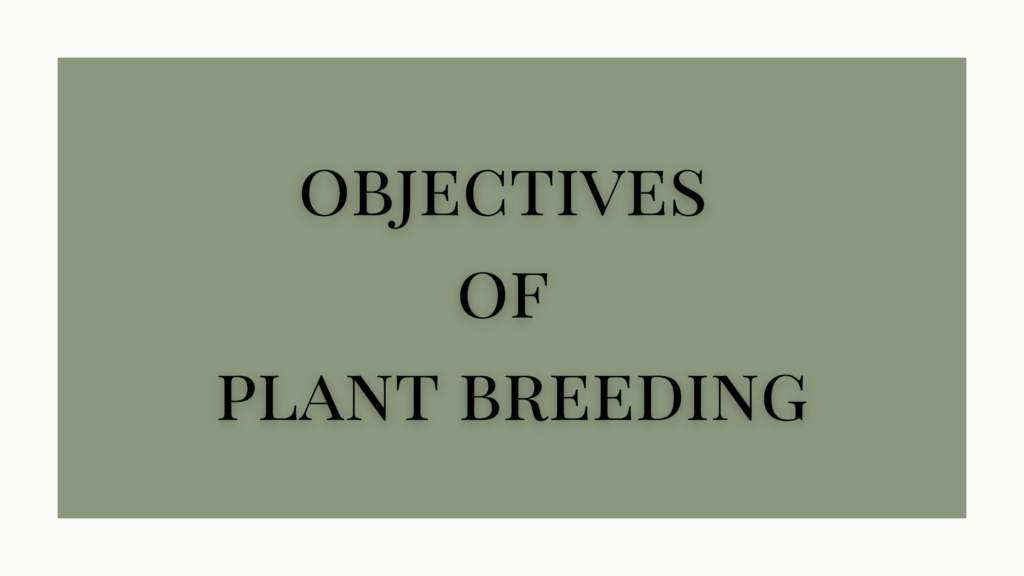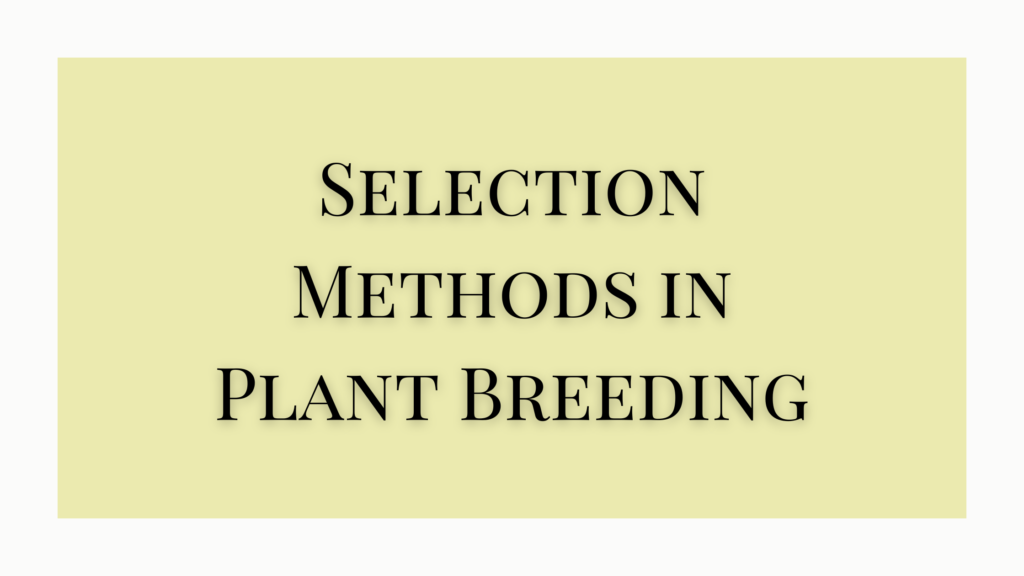Polyploidy is the condition of living cells have more than two sets of homologous chromosomes. Although this is a natural phenomenon, some plants are often bred by inducing polyploidy to produce new plant varieties with unique characteristics. This method is called polyploidy breeding. Polyploidy breeding in plants is a widely used method for producing new crop plants.
Polyploids are abundant in nature. The fact that more than half of crop plants are polyploids shows that polyploidy has played a significant role in speciation. With the discovery that colchicine ( a poisonous chemical isolated from Colchicum autumnale)could induce polyploidy artificially, this chemical is used for polyploidy breeding in plants, specifically for crop plants to obtain novel and economically superior cultivations.
Polyploidy Breeding in Plants
Polyploidy is the most rapid method to produce radically different vigorous and well-adapted genotypes. As a result of the doubling of the chromosomes, the genetic makeup of an organism or plant is changed. In the majority of cases, polyploidy causes an increase in cell contents. There is an increased effect as the dose of the gene increases. This is called the dosage effect.
There are cases where hybrid does not show any increased effect. Eg. Dr. Abraham (1963) noticed a decrease in the oil content of coconut with an increase in ploidy.
Polyploidy is advantageous for vegetatively propagated plants. Polyploidy breeding is a revolutionary step in this line. There was universal interest in doubling the chromosomes in plants. Several breeding techniques were employed in Japan, Sweden, Russia, etc.
Effect of Colchicine
Colchicine inhibits the formation of the spindle during meiotic division. This prevents the sister chromatids from moving to the poles. As a result, the nucleus formed includes both the sister chromatids leading to the doubling of the chromosome number in the gametes. At the same time, cells respond to colchicine only when they are dividing.
Usually, the reproductive parts of the desired plant are exposed regularly to colchicine so that it can affect the meiotic division during gamete formation. For this treatment, a 0.2% solution of colchicine is prepared. A cotton ball soaked in this solution is applied to the reproductive parts. The plant is constantly monitored during this process.
Types of Polyploids
Autopolyploids
Autopolyploids are used in interspecific and intergeneric gene transfer. In autopolyploidy breeding, diploids are the ideal material to start for plants grown for vegetative parts and are better suited for this breeding.
Sometimes, the obtained autopolyploid material may not perform well, but it provides raw materials for breeding programs to produce superior types.
Allopolyploids
Allopolyploids have genomes from two or more species. Several of our crop plants are allopolyploids. Production of this type of polyploid has attracted considerable attention for creating new species. The present-day allopolyploids are most likely produced by chromosome doubling in F1 hybrids between two distinct species belonging to the same genus or two different genera.
The production of an allopolyploid involves two steps- the production of an F1-distant hybrid and chromosome doubling. Chromosome doubling is easy in plants since most plant species respond to colchicine. In such cases, other agents available for chromosome doubling may be useful. Wild cultivated wheat forms a series of diploids 2n14, tetraploids 4n28, hexaploids 6n42 and the basic number is 7, a heptaploid.
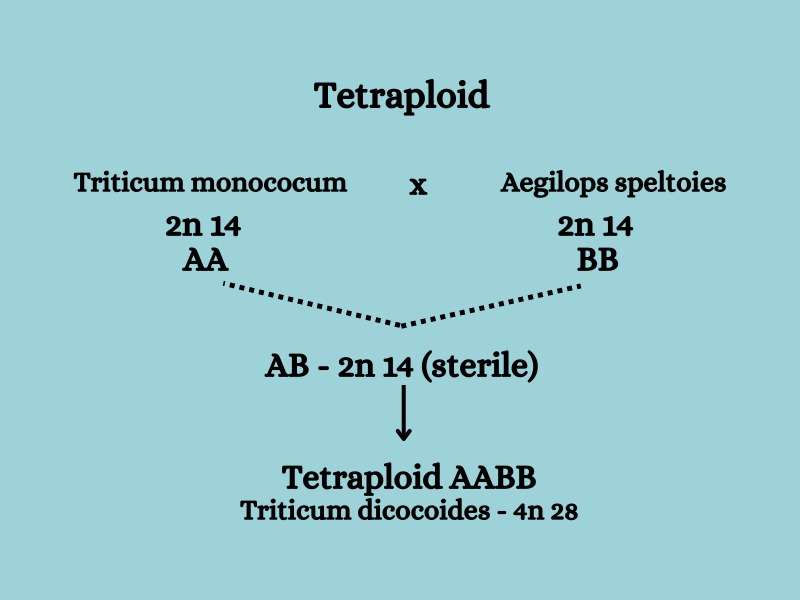
The bread wheat is hexaploid. Tetraploid emmer wheat contains two distinct genomes and they are supposed to have originated from amphidiploid between Triticum monococcum AA and Aegilops speltoides BB.
The hexaploid wheat arose as a result of hybridization between tetraploid emmer wheat AABB and a diploid species of Aegilops squarosa, having 2n DD followed by chromosome doubling in the hybrid.
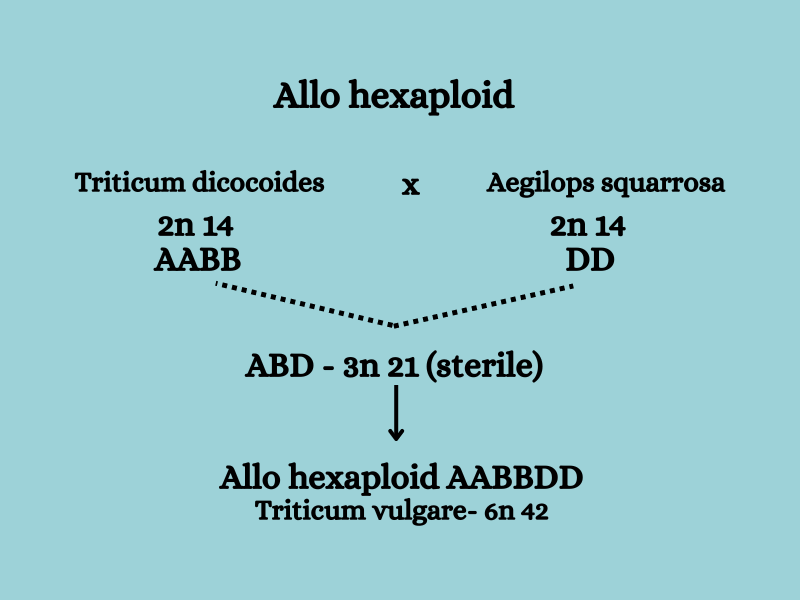
Synthetic hexaploid wheat has been produced by crossing T.durum 4n with Secale cereal (rye) 2n.
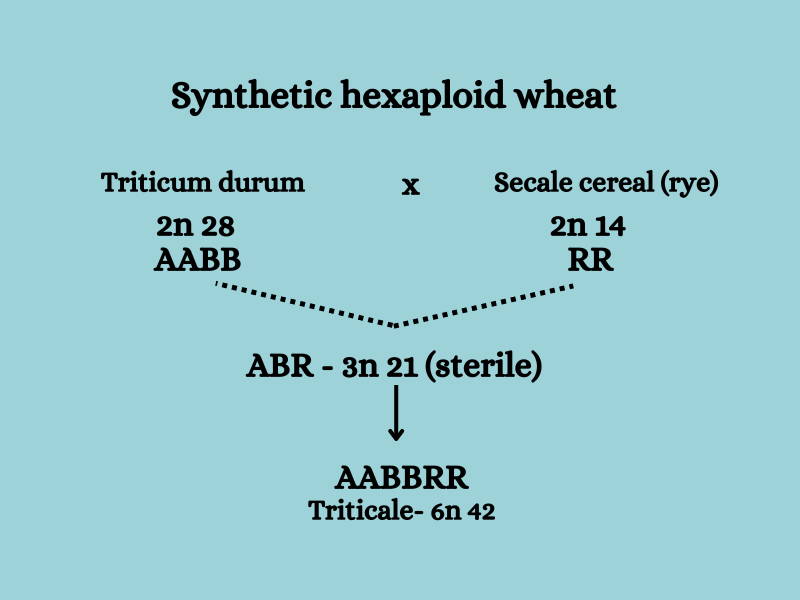
Triticale, one of the most successful artificial allopolyploids, is a cross between wheat with rye. Triticales derived from tetraploid wheat have been the most successful ones. Triticale is popularly known as wheat-rye having the hardness of rye and productivity and quality of wheat.
About 50 years of intensive research has improved the characteristics of Triticale considerably. A large number of allopolyploids have been synthesized between wheat and rye. Here the cross between T durum and rye produced 3n interspecific hybrids and by doubling their chromosomes, Triticale is produced. Four of these genomes have been contributed by wheat and the rest by rye.
Octaploid triticales- AABBDDRR has been developed as an allopolyploid between hexaploid wheat T. aestivum (AABBDD) and diploid Secale (RR).
Raphanobrassica results from an intergeneric cross between R. sativus and Brassica oleracea. F1 was sterile due to a lack of homology. When chromosomes were doubled, it produced amphidiploid Raphanobrassica. Amphidiploids refer to the doubling of non-identical chromosomes to give rise to allopolyploids.
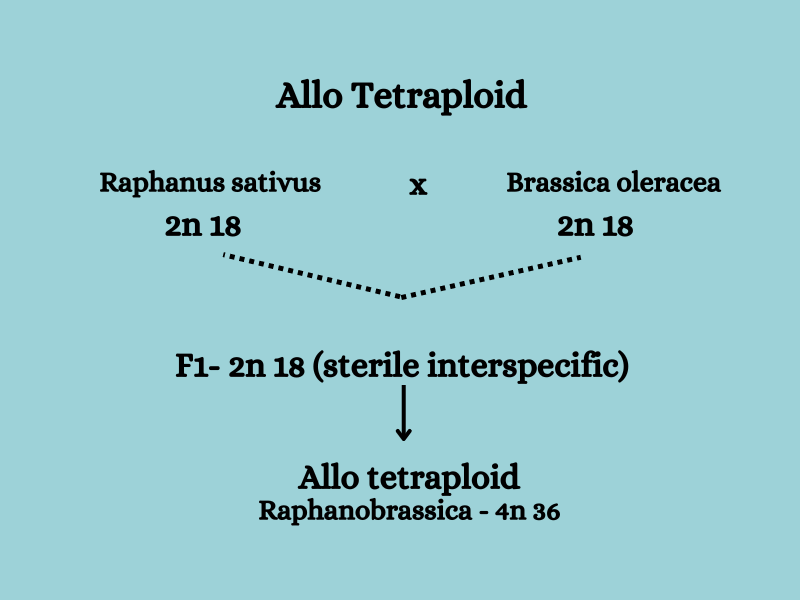
Two different species of tobacco are crossed to produce a new variety of Nicotiana tobaccum.
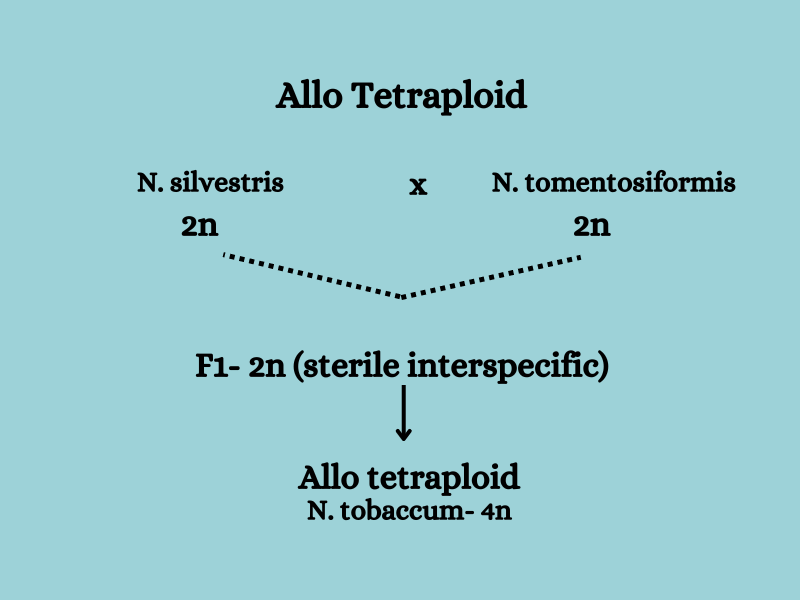
Role of Polyploidy Breeding in Plants
Polyploidy is the most rapid method to produce radically different, vigorous, and well-adapted genotypes. In addition, it is one of the best-known methods of the evolutionary process. In many cases, polyploidy shows definite advantages over diploid ancestors.
Polyploidy plays an important role in the production of many of our economically important plants and in the evolution process. Oats (Avina sativum), wheat, sugarcane, cotton, potato, tobacco, grass, fruits, vegetables, and flowering plants are natural polyploids of various degrees. Some autopolyploid-cultivated plants are potatoes, sweet potatoes, bananas, coffee, etc.
In general, Stebbins regarded that indication of polyploidy forms an evolutionary shortcut through which a genus can adapt more rapidly to a changing environment than by gene mutations or gene combinations.
In many cases, the intergeneric and interspecific hybrids will lead to sterile plants but when polyploidy is induced, they will become allopolyploids which are fertile with increased vigor and resistance.
So it is evident that polyploidy influences not only the morphological attributes of individuals but also has a profound effect on reproductive potentiality and genetic variability of progenies.
On the whole, we can say that polyploidy plays an important role in plant breeding programs because it is through this process that many new species originate within a short time.
References
- Plant Breeding Principles and Methods: B.D.Singh
- Polyploidy in Plant Breeding
Additional Reading
- Heterosis in Plant Breeding & Its Causes
- Mutation Breeding in Plants
- Disease resistance breeding


